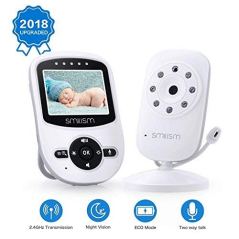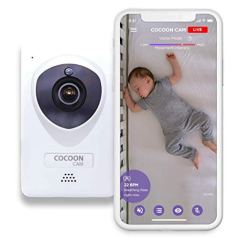BestReviews is reader-supported and may earn an affiliate commission. Details

This portable baby monitor makes it simple to keep an eye on your child at any time.
This portable baby monitor makes it simple to keep an eye on your child at any time.
Offers a real-time video connection so you can monitor your child without delay. Boasts a night-vision capability and provides crystal-clear images. Features temperature and sound monitoring capabilities. Can be paired with up to 4 cameras in different rooms. Comes with a user-friendly 2.4-inch color LED display.
Picture sometimes cuts in and out. Battery tends to die quickly.

This sound-only baby monitor has a good range and comes with 2 receivers.
This sound-only baby monitor has a good range and comes with 2 receivers.
Monitor set with 1 parent unit and 2 baby units. Secure connection. Has a range of 1,000 feet and LED lights for sound level. Features 2-way talk and a nightlight on the baby unit. Sound can be customized based on noise level.
This monitor sometimes has problems cutting out or failing to link.

This first-rate portable baby monitor provides HD video that you can quickly access on your smartphone or tablet.
This first-rate portable baby monitor provides HD video that you can quickly access on your smartphone or tablet.
Boasts both real-time breathing monitoring and night-vision HD video capabilities. Works in conjunction with a mobile app that enables you to receive instant alerts anywhere you go. Does not require any wearables, wires, or mats. Offers 2-way audio.
Sound quality leaves much to be desired. May be tough to connect the monitor to WiFi.

This superb portable baby monitor offers room temperature tracking, LED indicators, and many other terrific features.
This superb portable baby monitor offers room temperature tracking, LED indicators, and many other terrific features.
Comes with a 2.4-inch color LCD display that delivers crisp, clear images. Provides high and low room temperature alerts. Automatically detects dim light, enabling you to track your child in both bright and dark settings. Easy to place the monitor on a tabletop or mount it to a wall.
Sometimes emits white noise. Less durable than many comparable monitors.

This premium, portable baby monitor enables you to customize your viewing angle and zoom.
This premium, portable baby monitor enables you to customize your viewing angle and zoom.
Offers a compact monitor that features a worry-free retractable antenna. Provides remote pan, tilt, and digital zoom for unmatched maneuverability. Boasts a sound-activated LCD display. Comes with an audio-on, screen-off mode that you can use to help preserve the monitor's battery life.
Pricey in comparison to similar monitors. Emits a signal that tends to be weak and inconsistent.

We recommend these products based on an intensive research process that's designed to cut through the noise and find the top products in this space. Guided by experts, we spend hours looking into the factors that matter, to bring you these selections.

There’s an old saying that tells new parents to sleep when their baby sleeps. And there’s a reason we call it an old saying.
In today’s fast-paced world, you need to be getting things done while the baby sleeps, so you can spend quality time with her when she wakes up. Baby monitors that stay tethered near your nightstand are obsolete. You’re on the go — from your home office to the kitchen to the yard — and you need your monitor to keep up.
Portable baby monitors do just that. They can sit on your desk or come with you to the basement, keeping baby within earshot no matter where you are. Baby monitors range from basic audio-only models to those that have video screens and come with a variety of special features, including night vision and room-temperature and breathing alerts, which decrease the chance of Sudden Infant Death Syndrome (SIDS).
When it comes to baby products, you need the best, but you need to have money left for diapers, too. Keep reading to find the best monitor for your money, and check out our recommendations when you’re done.

The first thing you need to decide is whether you want a monitor that provides audio only or both video and audio.
Video monitors give you the full picture of what’s happening and lets you see why your baby is crying before you enter the room. It’s important to know whether your baby is upset because her foot is trapped between crib slats, or if she’s just unhappy because it’s naptime.
Audio-only monitors let you know when your baby is awake or upset — and that’s about it. However, they are usually less expensive than video monitors, and they run down the batteries less quickly.
If you’re not sure what you want, look for monitors that allow you to turn the screen off but keep the audio working. That way, you can switch the video off if it’s unnecessary or using too much power.
If you decide on a video monitor, you also need to choose how you want to see your video displayed. Many monitors use an app to send video to your smartphone or tablet. This style is convenient if you, like many people, keep your phone with you all the time. Using your phone can even save you some money; monitor systems that use your phone often cost less because you’re not buying a separate screen.
Phone-based monitors do have their drawbacks though. If you use your phone frequently, for business calls or other reasons, you may not be able to access it when you want. Or if the battery runs down quickly, you might not have enough power to monitor your baby. You will also need access to a stable WiFi connection. And you risk interruptions from notifications if you keep your phone in your bedroom at night to monitor your baby.
If these drawbacks are deal breakers, you can get a monitor with a dedicated portable video display. These often prove more reliable, because they aren’t dependent upon WiFi or your phone working properly. They are, however, more expensive.
All monitors offer one-way audio — relaying sound from your baby’s room to your unit. Some, however, let you speak through the monitor into your child’s room. Two-way audio options give you flexibility by letting you soothe your baby from a different room. They also let you give instructions to older children in the room. Just make sure there’s an easy way to mute the audio going into your child’s room, so stray household noises don’t wake your baby.
Video is most helpful if you can see what’s happening, when it’s happening. Video monitors should relay images in real time, so you can respond quickly to urgent situations. They should also be high-definition and include night-vision capability, so that you can see the baby even when it’s dark. Monitors that stream video to your phone over an app should be encrypted for security.
Disposable batteries are usually more expensive over time, but they give you more flexibility. When your batteries run out, you can replace them with fresh ones quickly.
Some monitors can detect when baby’s breathing slows or stops — a factor in SIDS. Some monitors use sensor pads that go under the crib mattress. Others detect breathing motion and monitor heart rate with heat mapping or ultrasonic waves.
Some portable monitors alert you if baby’s room temperature is too chilly or too hot. Rooms that are too cold are uncomfortable for babies; rooms that are too warm may increase the risk of SIDS.
Range: If you have older children who need supervision outdoors or an especially large home, make sure your monitor relays signals over a long enough distance.
Sound/movement detection: Some monitors “sleep” until sound or movement in the baby’s room triggers them.
Display size: Is the display large enough to clearly see what’s happening in the baby’s crib?
Mounting: Video monitors must be mounted for a clear image. Know where and how you’ll attach the camera before you buy.
Adjustable: Some video monitors can pan, swivel, and tilt for better images.
Inexpensive: You can find basic portable baby monitors for $20 to $40 that will be audio-only. Lower-priced monitors in this range will have one-way audio; higher-priced ones may offer two-way audio. They will not include value-added features like breath, heart rate, or temperature monitoring.
Mid-range: For $75 to $125, you’ll find basic video monitors as well as more advanced models that transmit to a smartphone. Some in this range may simply relay video, including night-vision capability; others may include breath monitoring and other extras.
Expensive: The most expensive portable monitors can cost $150 or more. These systems include a base and a portable video monitor, so your phone is free for other tasks. It should include lots of options for audio or video use and sound detection as well as temperature and breathing alerts. Video should be transmitted in real-time with no lag and without relying on WiFi.

If you suspect you will set down and forget your portable monitor, choose one that clips to a belt loop.
Adjustable sensitivity settings can help prevent false alarms, which are especially disruptive when you’re sleeping.
Monitors that emit a lot of blue light — either on the base unit or the monitor — can disrupt sleep for you or your baby.
WiFi-based monitors require a stable signal, so keep this in mind if the signal is weak in certain parts of your home.
If you’re using WiFi, make sure you use a strong password to keep your video feed private.

Q. How long of a range does my portable baby monitor need?
A. It depends upon your space. Most baby monitors feature a range between 600 and 1,000 feet. This is plenty of coverage for the average apartment or single-story house. If you live in a two-story house, or if your house is more than 2,000 square feet, look for a monitor with a range of more than 1,000 feet. Some monitors boast 3,000 to 5,000 square feet of coverage, which may be overkill unless you have a large yard and plan to spend naptime weeding.
Keep in mind that the labeled square footage might not match reality. Thick walls, metal pipes, and other electronic devices can create interference with your monitor. If you need a really long range, you can’t beat an audio monitor. WiFi-based video monitors are another choice, since you can access an app anywhere, but remember these monitors are dependent upon a strong WiFi signal and mobile-device connection.
Q. Do I really need a video monitor, or will an audio monitor do the job?
A. Audio monitors do what they’re designed to do — let you hear what’s going on in your baby’s room. There’s nothing wrong with them, but if a video monitor fits in your budget, we recommend them. Nothing gives you peace of mind like viewing your baby sleeping safely over the monitor. But they’re practical, too. You don’t need to go into the nursery — and potentially wake a sleeping baby — just to make sure everything is fine. And reading cries can be hard for first-time parents. Is your baby crying because he’s in trouble or because he doesn’t want to nap? Without a video feed, you have incomplete information. If you can afford the technology, it really makes life safer — and simpler.
Q. A smartphone-based monitor sounds convenient, since I already take it everywhere with me. Do I really need a separate display?
A. It depends. If you use your phone mostly to text, take pictures of your baby, and to keep up with social media, using it as a monitor could save you some money. But if you use it for work or other professional functions, a monitoring app could interfere. You’ll also need to decide whether you want to keep your phone next to your bed at night to use as a monitor. If so, look for apps that let you silence notifications but still hear your monitor.
Get emails you’ll love.
Learn about the products you’re wondering if you should buy and get advice on using your latest purchases.
